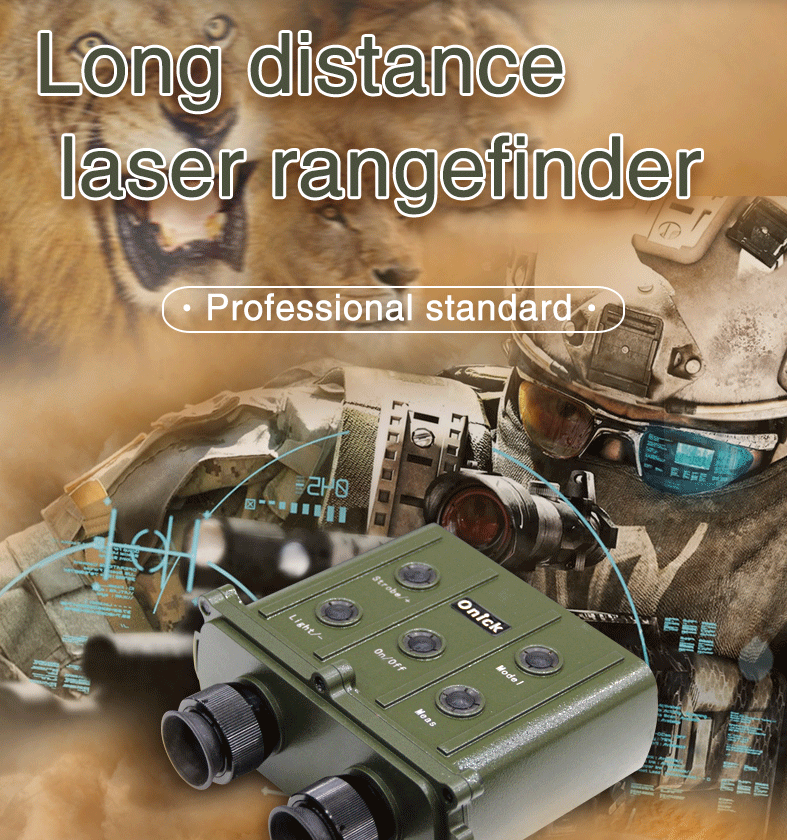In the ever-changing and treacherous modern military battlefield, accurately determining target distance is a crucial prerequisite for combat decision-making and operational execution. Whether scouts are quietly infiltrating reconnaissance, artillerymen are precisely calibrating their shots, or special forces are planning lightning-fast raids, military long-range rangefinders play an indispensable role, serving as the "distance controllers" on the battlefield.
Operating Principle: Precision Measurement Through the Interweaving of Technology
Laser Ranging Principle
Currently, laser ranging is widely used in military long-range rangefinders. Its core operating mechanism is based on the high directivity, high monochromaticity, and high energy characteristics of lasers. For example, a common pulsed laser rangefinder emits an extremely brief, highly concentrated laser pulse toward a target. After reaching the target, this laser beam is reflected by the target's surface and captured by the rangefinder's receiver. Since laser light travels at a nearly constant speed of light in air, the rangefinder simply measures the time elapsed between the laser pulse's emission and reception. Using the product of the speed of light and time, the rangefinder can accurately calculate the distance between the target and the rangefinder. For example, the TFN MKI series long-range laser rangefinders utilize an Nd:YAG laser with a wavelength of 1.064 microns. This specific wavelength gives them powerful penetration and excellent anti-interference capabilities, enabling them to reliably measure distances from 30 meters to 10,000 meters (depending on the model) in complex and harsh battlefield environments, with an accuracy of ±0.5 meters (mean error), providing critical and accurate data support for military operations.
Phase-Based Ranging Principle
In addition to pulsed laser ranging, phase-based ranging is also used in some high-end military rangefinders. This principle involves emitting a modulated continuous laser beam. As the laser beam travels back and forth between the target and the rangefinder, its phase changes accordingly. The rangefinder precisely measures this phase change and, combined with parameters such as the laser's modulation frequency, uses a specific mathematical formula to indirectly calculate the target's distance. The outstanding advantage of phase-based ranging is its extremely high measurement accuracy, typically reaching millimeter levels. However, its measurement range is relatively limited. In the military, it is primarily suitable for close-range measurements where precision is critical, or as a supplementary calibration method for long-range measurements.
Key Feature: Guaranteed Performance in Harsh Battlefields
Ultra-Long Range
Military operations often involve the detection and monitoring of targets at long distances, so military long-range rangefinders must possess impressive ultra-long range. For example, the Onick CL series binocular handheld laser rangefinders offer a measurement range of 30 to 20,000 meters. This allows reconnaissance personnel to monitor enemy positions, equipment, facilities, or moving targets from extremely long distances, obtaining critical intelligence in advance and providing ample time for combat commanders to make decisions.
High-Precision Measurement
On the battlefield, even the slightest error in distance data can lead to operational failure, so high accuracy is the core requirement for military long-range rangefinders. Most advanced military rangefinders maintain a stable accuracy of within ±1 meter, with some leading products even achieving sub-meter accuracy. For example, the Onick CL series rangefinders mentioned above, with their ±0.5-meter (mean error) ranging accuracy, enable reconnaissance personnel to accurately determine target locations in complex and ever-changing battlefield environments, providing a solid and reliable data foundation for subsequent fire strikes and troop deployment.
Strong Anti-Interference Capability
The battlefield environment is rife with interference factors, such as electromagnetic interference, inclement weather (rain, snow, fog, dust, etc.), and obstructive terrain. To effectively combat these interferences, military long-range rangefinders incorporate a series of advanced technologies and protective measures in their design. In the optical system, special coatings and anti-reflective materials are used to reduce light scattering and reflection interference, enhancing image clarity in adverse lighting conditions. In the circuit system, shielding and filtering techniques are employed to minimize the impact of electromagnetic interference on the device's internal circuitry. The structural design emphasizes waterproofing, dustproofing, and vibration resistance, ensuring stable operation in harsh environments. Take the TFN M series rangefinder, for example. Its main structure features a sealed, waterproof, and vibration-resistant design. It operates in a wide temperature range of -30°C to +60°C and can withstand a maximum relative humidity of 95-98%. Even in harsh environments like windy rain and dusty sandstorms, it maintains stable operation and continuously outputs accurate distance data.

Fast Measurement and Data Processing
On the battlefield, where time counts, rapidly acquiring and processing distance data is crucial. Modern military long-range rangefinders boast high-speed data acquisition and processing capabilities. From pressing the measurement button to displaying accurate distance data, it often takes only seconds or less. Furthermore, some high-end devices integrate advanced data analysis algorithms, automatically calculating key parameters such as target speed, azimuth, and elevation based on measurement data. This provides combat personnel with more comprehensive and intuitive target information, enabling them to make quick and accurate decisions.
Portability and Durability
The mobility of military operations requires rangefinders to be highly portable, enabling soldiers to quickly carry and operate them in various combat scenarios. Modern military long-range rangefinders are designed with this in mind, employing lightweight materials and compact designs to significantly reduce their weight and size. For example, some handheld rangefinders weigh only a few kilograms and are about the size of a regular telescope, making them easy for soldiers to carry and use for distance measurement. Durability is also a crucial consideration for military equipment. Rangefinders must withstand the rigors of the battlefield, including frequent collisions, severe vibrations, extreme temperature fluctuations, and corrosive environments. Therefore, the device casings are typically constructed of high-strength, corrosion-resistant materials, and internal components undergo rigorous screening and reinforcement to ensure stable and reliable performance even during long-term, intensive use.
Typical Application Scenarios: Comprehensively Assisting Combat Operations
Reconnaissance and Intelligence Gathering
During military reconnaissance missions, scouts must covertly and remotely obtain detailed enemy intelligence, including information on enemy positions, troop deployments, equipment configurations, and fortifications. Military long-range rangefinders are essential tools for these missions. Scouts use rangefinders to precisely measure the distance between enemy targets and themselves. Combined with other reconnaissance methods (such as telescopic observation and drone-assisted reconnaissance), they can create a detailed and accurate picture of the enemy's situation. For example, in complex terrain such as mountainous jungles, the TFN MKI series rangefinders, with their ultra-long range and high-precision measurement capabilities, enable scouts to measure the distances between hidden enemy outposts and strongholds without exposing themselves, providing critical information for subsequent operational planning.
Artillery Fire Calibration
As the "firepower" on the battlefield, the accuracy of artillery fire is directly related to the outcome of a battle. Before conducting an artillery attack, artillery units must precisely determine the target's distance, direction, and altitude to accurately calibrate and aim their artillery. Military long-range rangefinders work in conjunction with artillery positioning systems, fire control computers, and other equipment to quickly and accurately measure target distances and transmit this data in real time to the fire control system. Based on this data, the fire control system calculates the artillery's firing parameters (such as firing angle and charge), enabling precise targeting. For example, during a live-fire exercise, an artillery unit used a reconnaissance vehicle equipped with a high-precision rangefinder to rapidly measure the distance to a simulated enemy target several kilometers away. Through precise calculations and artillery adjustments by the fire control system, the first round of artillery fire successfully hit the target, fully demonstrating the critical role of rangefinders in artillery operations.
Special Operations
When conducting missions, special forces often must conduct precision strikes or covert infiltration against specific targets in complex and dangerous environments. In such situations, accurately determining the target's distance is crucial to the success of the operation. Military long-range rangefinders enable special forces members to accurately determine target locations from a distance, plan routes, and ensure the concealment and safety of their operations. For example, during urban counterterrorism operations, special forces members use handheld rangefinders to measure the distance between themselves and the room where terrorists are located, from hidden locations in buildings. This allows them to develop detailed tactical plans for subsequent assaults and improve the success rate of the operation. Target Monitoring and Tracking
In military confrontations or protracted warfare, continuous surveillance and tracking of key enemy targets, allowing timely understanding of their movements and changes, is crucial for controlling battlefield situational awareness and making operational decisions. Military long-range rangefinders can be integrated with other surveillance equipment (such as infrared thermal imagers and electro-optical tracking systems) to achieve all-round, all-weather monitoring of targets. By continuously measuring changes in target distance and combining them with parameters such as the target's trajectory and speed, combatants can accurately predict the target's next move and prepare for response. For example, during border patrols, border troops use electro-optical reconnaissance equipment equipped with ranging capabilities to conduct long-term surveillance and tracking of suspicious targets crossing the border. Once any unusual target movement is detected, appropriate measures can be taken promptly.
Development Trend: Cutting-Edge Technology Leads Innovation
Intelligent Upgrade
With the rapid development of cutting-edge technologies such as artificial intelligence and big data, military long-range rangefinders are making significant strides towards intelligentization. Future rangefinders are expected to integrate advanced image recognition and analysis algorithms, enabling them to automatically identify different types of targets (such as personnel, vehicles, and equipment) and automatically optimize measurement parameters based on target characteristics and environmental factors, improving measurement accuracy and efficiency. Furthermore, leveraging big data analytics, rangefinders can deeply mine and analyze historical measurement data, providing combatants with more valuable intelligence, such as target movement patterns and common activity areas.
Multi-Technology Integration
To further enhance the performance of rangefinders in complex battlefield environments, multi-technology integration has become a key development trend. On the one hand, laser ranging technology will be integrated with other ranging technologies (such as millimeter-wave radar and ultrasonic ranging), leveraging their complementary strengths to achieve more accurate and reliable long-range measurements. On the other hand, rangefinders will be deeply integrated with various advanced sensor technologies (such as infrared thermal imaging, low-light-level night vision, and Beidou positioning) to create a more powerful and comprehensive reconnaissance and observation system, providing combatants with comprehensive, multi-dimensional target information. Miniaturization and Lightweighting
The pursuit of smaller size and lighter weight, without sacrificing performance, has always been a key development direction for military equipment. In the future, with continuous breakthroughs in new materials and micro-nano manufacturing technologies, military long-range rangefinders will achieve further miniaturization and lightweighting while maintaining high accuracy and reliability. This will not only help improve soldiers' combat mobility and operational flexibility, but also reduce equipment energy consumption and production costs, improving the overall cost-effectiveness of the equipment.
Enhancing Anti-Interference and Concealment
Facing the increasingly complex and volatile electromagnetic environment of future battlefields and advanced enemy electronic countermeasures, enhancing anti-interference capabilities and concealment will become key research and development priorities for military long-range rangefinders. By employing advanced technologies such as novel anti-interference coding, low probability of intercept laser technology, and adaptive filtering algorithms, rangefinders can effectively resist various electromagnetic interference and enemy electronic reconnaissance, ensuring stable operation even in intense confrontational environments while minimizing the risk of enemy detection. Military long-range rangefinders, thanks to their critical role and constantly evolving technology, hold a crucial position in the modern military landscape. With continued technological advancement, they are poised to become even more effective on future battlefields, providing solid and powerful support for enhancing military combat capabilities.


